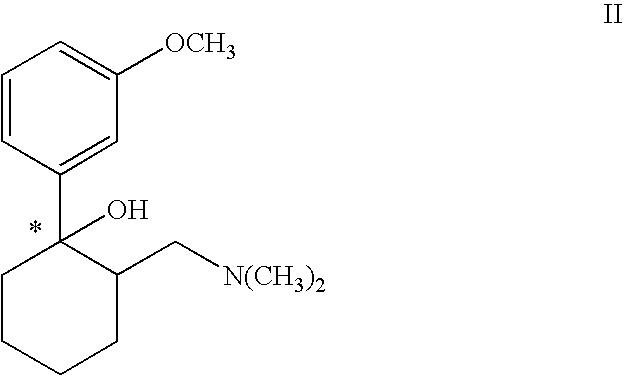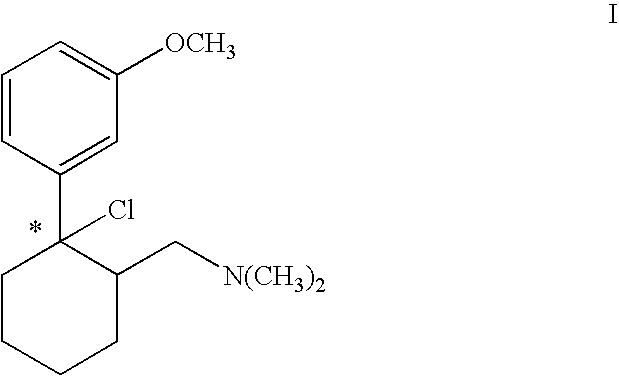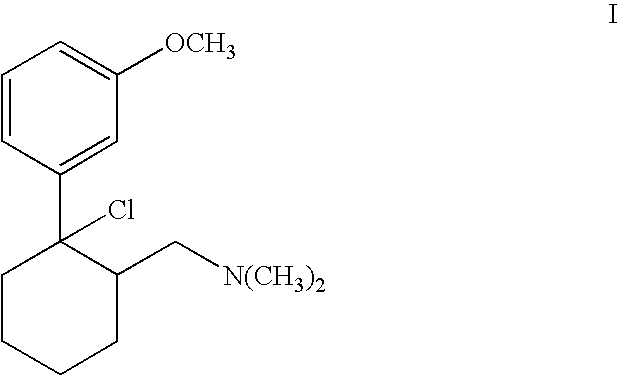Process for chlorinating tertiary alcohols
a technology of tertiary alcohols and chlorinated alcohols, which is applied in the field of chlorinating tertiary alcohols, can solve the problems of large quantities of thionyl chloride and poor yield (maximum of 55% of theoretical)
- Summary
- Abstract
- Description
- Claims
- Application Information
AI Technical Summary
Benefits of technology
Problems solved by technology
Method used
Image
Examples
example 1
Chlorination using Thionyl Chloride: Production of (1S,2S)-[2-chloro-2-(3-methoxy-phenyl)-cyclohexylmethyl]-dimethylamine hydrochloride
[0029] 3 kg (10 mol) (1S,2S)-2-dimethylaminomethyl-1-(3-methoxy-phenyl)-cyclohexanol hydrochloride were suspended in 10 l toluene and heated to 30° C. 1.9 kg (16 mol) thionyl chloride were added within 10 min. The mixture was heated to 35° to 45° C. A clear solution was produced after 2 to 3 hours. Further processing was effected according to variant A or B.
Variant A:
[0030] 3 kg toluene were distilled off under vacuum via a gas washer. Hydrogen chloride gas and sulphur dioxide escaped as the toluene was distilled off. The mixture was then cooled to 2° C. and stirred for 2 hours at this temperature. The precipitate was centrifuged off and thoroughly rewashed with toluene. The product could be used directly or after drying for subsequent hydrogenation. The yield was 2.87 kg (90% of theoretical) (1S,2S)-[2-chloro-2-(3-methoxyphenyl)-cyclohexylmethyl...
example 2
Heterogeneously Catalysed Hydrogenation: Hydrogenation of (1S,2S)-[2-chloro-2-(3-methoxy-phenyl)-cyclohexylmethyl]-dimethylamine hydrochloride
[0033] 3.18 kg (10 mol) (1S,2S)-[2-chloro-2-(3-methoxy-phenyl)-cyclohexylmethyl] dimethylamine hydrochloride (from Example 1) were dissolved in 15 l methanol, and 350 g palladium on activated carbon 5% were added. Hydrogen was introduced at normal pressure and ambient temperature until hydrogenation was complete. The catalyst was suction filtered, the solvent concentrated to a small volume and the base liberated using aqueous sodium hydroxide solution. After shaking out the aqueous phase using ethyl acetate and distilling off the organic solvent 2.47 kg (100% of theoretical) (1R,2R)-[2-(3-methoxyphenyl)-cyclohexylmethylamine]-dimethylamine as a slightly yellow colored oil remained.
[0034] The oil was dissolved in acetone and the hydrochloride precipitated using hydrochloric acid gas. 2.27 kg (80% of theoretical) (1R,2R)-[2-(3-methoxy-phenyl)-...
example 3
Methylether Cleavage Using Methane Sulphonic Acid / Methionine: Production of (1R,2R)-3-(2-dimethylaminomethyl-cyclohexyl)-phenol hydrochloride
[0036] 2.83 kg (10 mol) (1R,2R)-[2-(3-methoxyphenyl)-cyclohexyl-methyl]-dimethylamine hydrochloride were suspended in a mixture of 8.70 l methane sulphonic acid and 1.50 kg (D,L) methionine and heated for 5 hours to 70° to 90° C. The mixture was cooled to 30° C. and adjusted using 32% aqueous sodium hydroxide solution to a pH of 12 to 14. The base was extracted with ethyl acetate. After concentrating the organic solvent and precipitation in acetone with hydrochloric acid gas (or aqueous hydrochloric acid) 1.86 kg (80%) (1R,2R)-3-(2-dimethylaminomethyl-cyclohexyl)-phenol hydrochloride with a content of <1% of the starting product (1R,2R)-[2-(methoxyphenyl)-cyclohexyl-methyl]-dimethylamine hydrochloride.
[0037] Recrystallisation from water produced colorless crystals (1.5 kg, 80%) of (1R,2R)-3-(2-dimethylaminomethyl-cyclohexyl)-phenol hydrochlor...
PUM
| Property | Measurement | Unit |
|---|---|---|
| Temperature | aaaaa | aaaaa |
| Temperature | aaaaa | aaaaa |
| Temperature | aaaaa | aaaaa |
Abstract
Description
Claims
Application Information
 Login to View More
Login to View More - R&D
- Intellectual Property
- Life Sciences
- Materials
- Tech Scout
- Unparalleled Data Quality
- Higher Quality Content
- 60% Fewer Hallucinations
Browse by: Latest US Patents, China's latest patents, Technical Efficacy Thesaurus, Application Domain, Technology Topic, Popular Technical Reports.
© 2025 PatSnap. All rights reserved.Legal|Privacy policy|Modern Slavery Act Transparency Statement|Sitemap|About US| Contact US: help@patsnap.com



